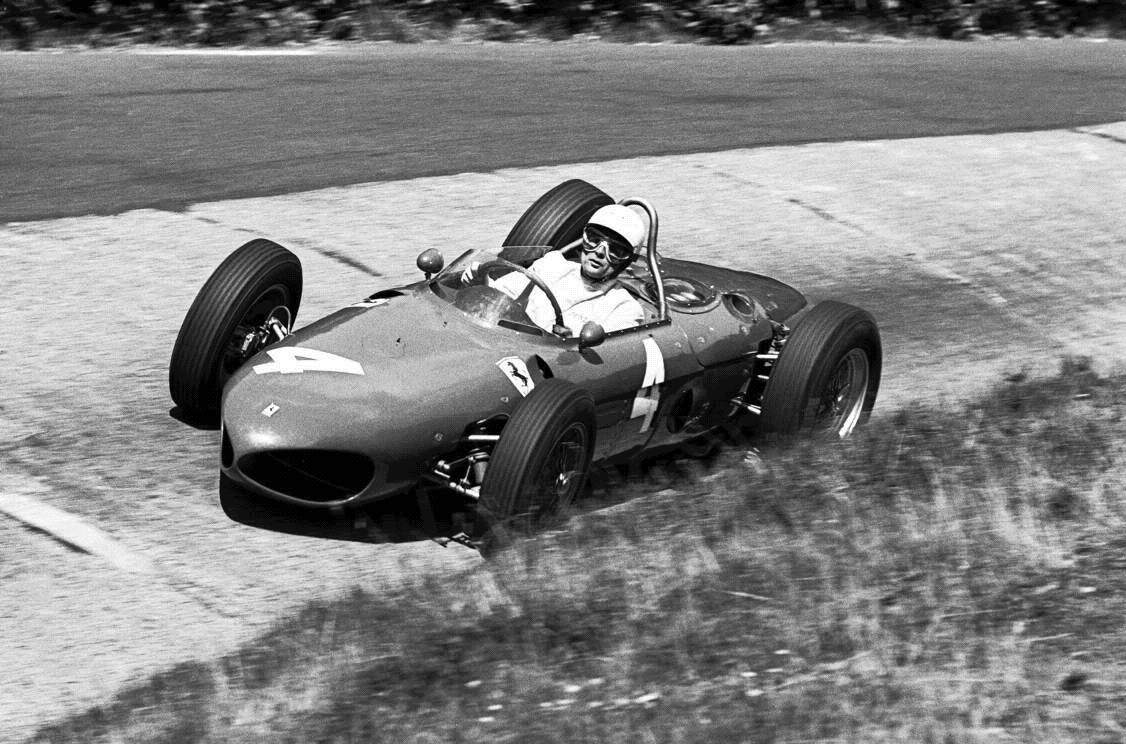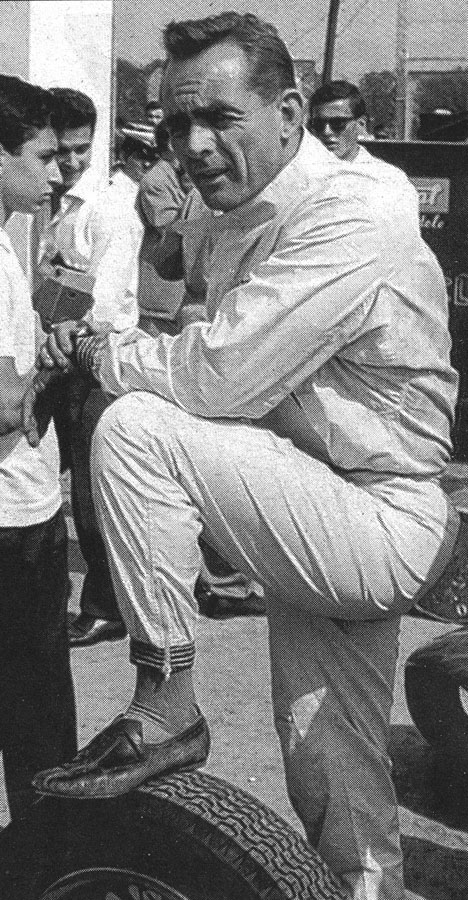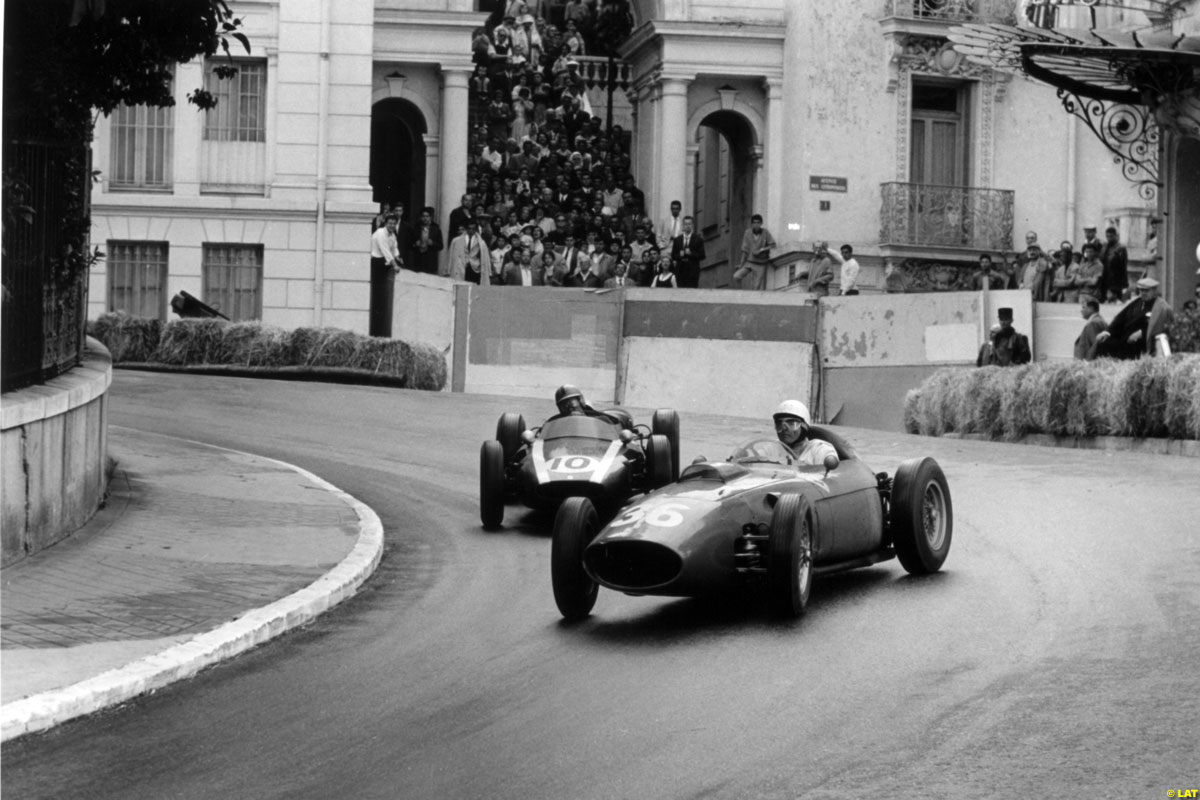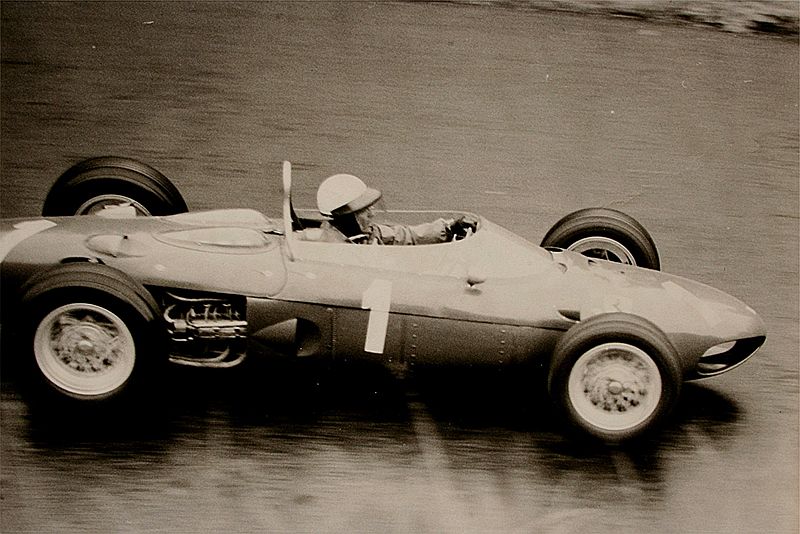<Back to Index>
- Race Car Driver John Michael Hawthorn, 1929
- Race Car Driver Philip Toll Hill, Jr., 1927
PAGE SPONSOR
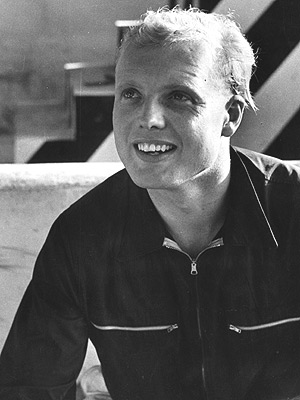
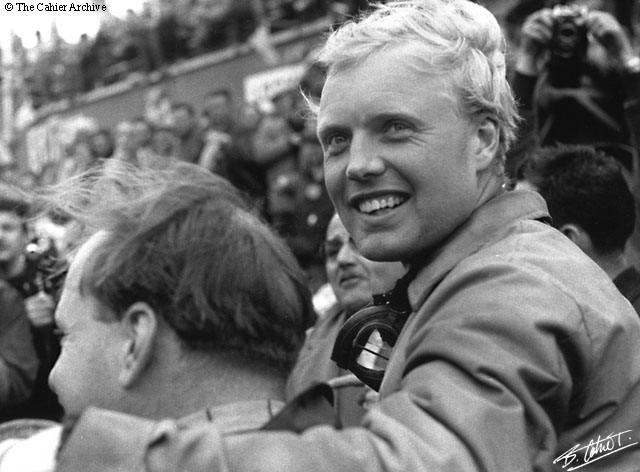
John Michael Hawthorn (10 April 1929 – 22 January 1959) was a racing driver, born in Mexborough, Yorkshire, England, and educated at Ardingly College, West Sussex.
Mike Hawthorn made his competition debut driving his 1934 Riley Ulster Imp, KV 9475, winning the 1,100 c.c. sports car class at the Brighton Speed Trials on 2 September 1950. In 1951, driving a 1½-litre T.T. Riley, he entered the Motor Sport Brooklands Memorial Trophy, a season long contest run at Goodwood, winning it by one point. He also won the Ulster Trophy Handicap at Dundrod and the Leinster Trophy at Wicklow that year.
Hawthorn made his Formula One debut at the 1952 Belgian Grand Prix, finishing in fourth place. He won his first Grand Prix, at the ninth attempt, at the 1953 French Grand Prix at Reims.
In 1955, Hawthorn was the winner of the 24 hours of Le Mans race, after an inspired drive, in which he set a lap record of 122 mph during a three hour duel with Fangio in the early stage of the race, which was followed by the terrible crash that killed 83 spectators and fellow racer Pierre Levegh, when Hawthorn, relaxing at the end of his stint, may have braked too hard in order to slow down before entering his pit, thus setting off a chain reaction. Another great drive at the Dunrod TT sharing the D Type with an inspired local Dennis Titterington, saw Hawthorn pass Fangio twice, only to lose the race in the final stages, when running on full tanks he was passed by Moss, and the D Types engine broke on the last lap. In 1957, Hawthorn joined the Ferrari factory team, and soon became friends with Peter Collins, a fellow Englishman and Ferrari team driver. During the 1958 racing season, the two Englishmen became engaged in a rivalry with Luigi Musso, another Ferrari driver, that spurred all three in a fierce competition for prize money. Musso was a serious rival for the championship Hawthorn was the winner of the fateful 1958 French Grand Prix at Rheims, in which Musso was killed while holding second place. Stirling Moss, driving for Vanwall, eventually took second place in the race, with Peter Collins coming in fifth.
Hawthorn was the winner of the 1958 Formula One Championship. He only one win that year against four wins of Stirling Moss, but was leading easily in the Monaco GP at half distance when his 246 engine blew, and at Monza was a minute ahead of Brooks when his clutch forced him to slow to a second gained when Phil Hill slowed, he benefited greatly from the gentlemanliness of Moss as shown at the Portuguese Grand Prix at Porto. Hawthorn was disqualified for pushing his car, against the rules, on the way to a second place finish. Moss interceded on Hawthorn's behalf and the decision was ultimately reversed. After a pit stop mid way through the race at Oporto, Hawthron stormed back through the field running two seconds under, the poll lap time of Stirling Moss, gaining an extra point for fastest lap, which Moss failed to respond to, possibly doubting Hawthorn could lap so fast with damaged drum brakes. This extra world championship point plus those second place points at Porto contributed to Hawthorn winning the championship with a season total just one point more than that of Moss. In the final race at Morocco, Hawthorn drove a conservative tactical race aiming to stay ahead of Moss's teammates. Brooks car broke while narrowly leading Hawthorn and Lewis Stuart Evans in the third Vanwall died of burns after crashing the Vanwall after a desperate attempt to move through the field and pass fourth placed Jo Bonnier and challenge Hawthorn running third. In the last laps second placed Phil Hill slowed and waved Mike through to gain enough points from second to take the Championship.
After winning the title, Hawthorn immediately announced his retirement from Formula One, having been badly affected by the death of his close friend and Ferrari team mate Peter Collins in that year's German Grand Prix.
Many years after the death of Mike Hawthorn, Fiamma Breschi, Luigi Musso's girlfriend at the time of his death, revealed the nature of Musso's rivalry with fellow Ferrari drivers Mike Hawthorn and Collins in a television documentary, The Secret Life of Enzo Ferrari. Breschi recalled that the antagonism between Musso and the two English drivers, encouraged all three to take more risks:
"The Englishmen (Hawthorn and Collins) had an agreement," she says. "Whichever of them won, they would share the winnings equally. It was the two of them against Luigi, who was not part of the agreement. Strength comes in numbers, and they were united against him. This antagonism was actually favorable rather than damaging to Ferrari. The faster the drivers went, the more likely it was that a Ferrari would win." Breschi related that Musso was in debt at the time of his death, and the money for winning the 1958 French Grand Prix (traditionally the largest monetary prize of the season), was all important to him.
After visiting the mortally wounded Musso in hospital, Breschi returned to her hotel, where she and the rest of the Ferrari team were informed by the team manager that afternoon that Musso had died. By the end of that year Collins and Hawthorn were also dead, and Breschi could not suppress a feeling of release. "I had hated them both," she said, "first because I was aware of certain facts that were not right, and also because when I came out of the hospital and went back to the hotel, I found them in the square outside the hotel, laughing and playing a game of football with an empty beer can. So when they died, too, it was liberating for me. Otherwise I would have had unpleasant feelings towards them forever. This way I could find a sense of peace."
Hawthorn had previously lost a kidney to infection and began suffering problems with his remaining kidney in 1955. He was expected at the time to live only a few more years.
A matter of only months into his retirement, on 22 January 1959, Hawthorn died in a road accident on the A3 bypass near Guildford driving his British Racing Green highly tuned Jaguar 3.4-litre sedan (now known as the 3.4 Mk 1). The cause of the accident is still unknown, suggested causes being driver error, mechanical failure, or blackout. There is evidence that Hawthorn had recently suffered blackouts, perhaps because of kidney failure, that might well have caused the accident.
In Farnham, the town where he lived up to the time of his death, there is a street named Mike Hawthorn Drive (off Dogflud Way). It was also in this town that Hawthorn ran The Tourist Trophy Garage. Jaguars, Rileys, Fiats and Ferraris were serviced and sold from there.
There is a corner named after him at the Croft racing circuit, at Croft on Tees in North Yorkshire.
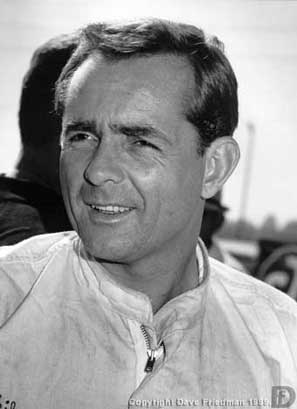
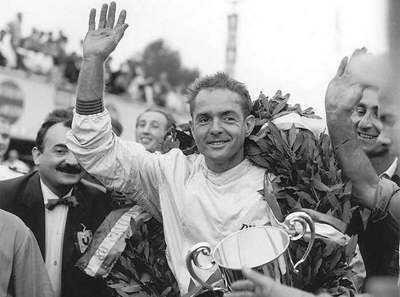
Philip Toll Hill, Jr. (April 20, 1927 – August 28, 2008) was a United States automobile racer and the only American born driver to win the Formula One World Drivers' Championship. Hill was described as a "thoughtful, gentle man" and once said, "I'm in the wrong business. I don't want to beat anybody, I don't want to be the big hero. I'm a peace loving man, basically."
Born in Miami, Florida, Hill was raised in Santa Monica, California, where he lived until his death. He studied business administration at the University of Southern California from 1945 - 47 where he was a member of the Kappa Sigma fraternity. Hill left early to pursue auto racing, working as a mechanic on other drivers' cars. Hill began racing cars at an early age, going to England as a Jaguar trainee in 1949 and signing with Enzo Ferrari’s team in 1956. He made his debut in the French Grand Prix at Reims France in 1958 driving a Maserati. That same year, paired with Belgian teammate Olivier Gendebien, Hill became the first American-born winner of the 24 Hours of Le Mans with Hill driving most of the night in horrific rainy conditions. He and Gendebien would go on to win the famous endurance race again in 1961 and 1962.
Hill began driving full time for the Ferrari Formula One team in 1959, earning three podium finishes and fourth place in the Driver's Championship. In 1960 he won the Italian Grand Prix at Monza, the first Grand Prix win for an American driver in nearly forty years, since Jimmy Murphy won the 1921 French Grand Prix. This also turned out to be the last win for a front - engined car in Formula 1. The following season, Hill won the Belgian Grand Prix and with two races left trailed only his Ferrari teammate Wolfgang von Trips in the season standings. A crash during the Italian Grand Prix killed von Trips and fifteen spectators. Hill won the race and clinched the championship but the triumph was bittersweet. Ferrari's decision not to travel to America for the season's final round deprived Hill of the opportunity to participate in his home race at Watkins Glen as the newly crowned World Champion. When he returned for the following season, his last with Ferrari, Hill said, "I no longer have as much need to race, to win. I don't have as much hunger anymore. I am no longer willing to risk killing myself."
After leaving Ferrari at the end of 1962, he and fellow driver Giancarlo Baghetti started for the new team ATS created by ex - Ferrari engineers in the great walkout of 1961. In 1964 Hill continued in Formula One, driving for the Cooper Formula One Team before retiring from single seaters at the end of the season and limiting his future driving to sports car racing with Ford Motor Company and the Chaparral Cars of Jim Hall before retiring from racing altogether in 1967.
Phil Hill has the distinction of having won the first (a 3 lap event at Carrell Speedway in a MG TC on July 24, 1949) and last races of his driving career, the final victory driving for Chaparral in the BOAC 500 at Brands Hatch in England in 1967.
Following his retirement, Hill built up an award winning classic car restoration business in the 1970s called Hill & Vaughn with business partner Ken Vaughn, until they sold the partnership to Jordanian Raja Gargour and Vaughn went on to run a separate business on his own in 1984. Phil remained with Gargour at Hill & Vaughn until the sale of the business again in 1995. Hill also worked as a television commentator for ABC's Wide World of Sports.
Hill had a long and distinguished association with Road & Track magazine. He wrote several articles for them, including road tests and retrospective articles on historic cars and races. He shared his "grand old man" status at R&T with '60s racing rival Paul Frère, who also died in 2008.
Hill, in his last years, devoted his time to his vintage car collection and judged at the Pebble Beach Concours d'Elegance more often than any other individual; 2007 was the 40th time he had judged the event.
Hill was married to Alma, and had three children: Derek, Vanessa and Jennifer. Derek raced in International Formula 3000 in 2001, 2002 and 2003, but was forced to retire when Hill became ill with Parkinson's Disease.
After traveling to the Monterey Historic Automobile Races in August 2008, Hill was taken to a hospital, where he died after a short illness from complications of Parkinson's Disease in Salinas, California, on August 28.
